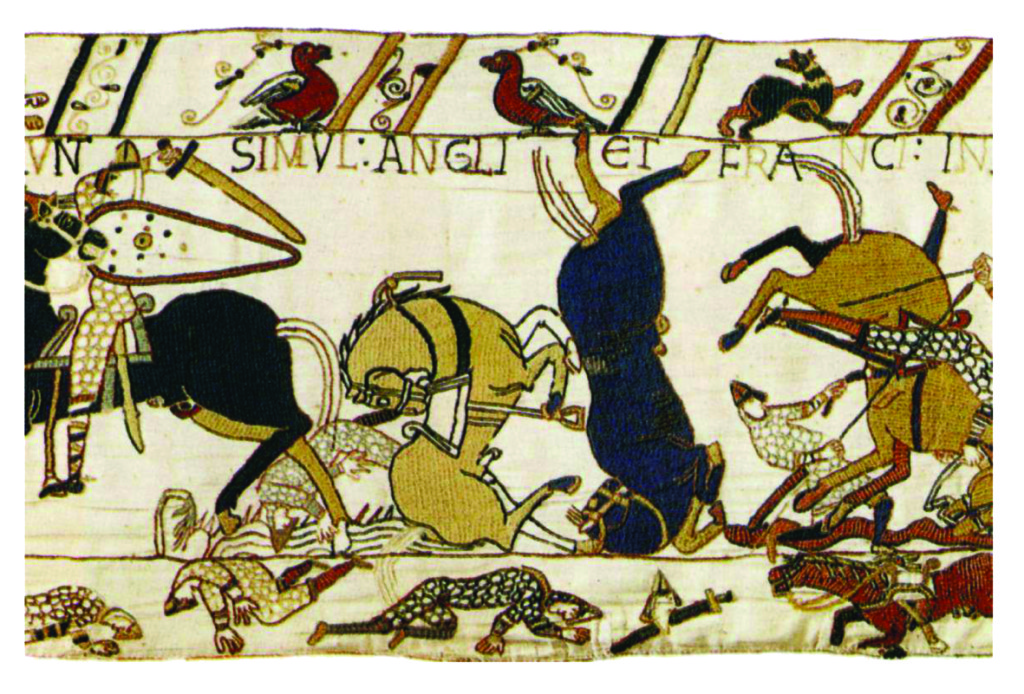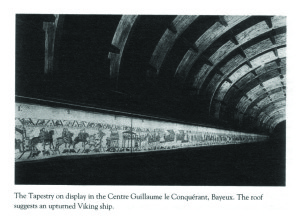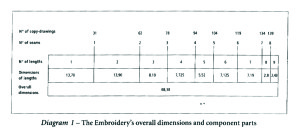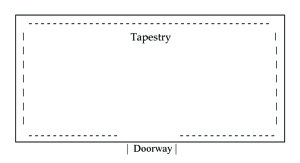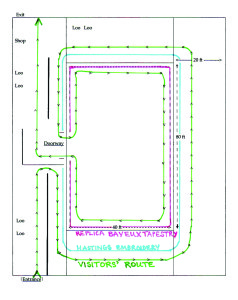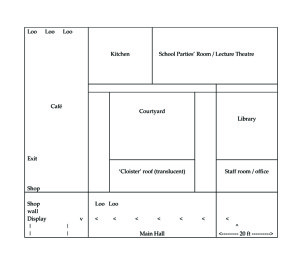1066 Centre – a bold new plan from Heather Grief
The following is taken from text supplied by Heather Grief.
LOCAL HISTORIAN HEATHER GRIEF HAS PUBLISHED A BOLD NEW PLAN FOR A 1066 CENTRE
Images from the Bayeux Tapestry appear all over the place in Hastings ‘ephemera’, but if we want to look at the original, we have to go to Bayeux. Unfortunately, the way that it is displayed there may be good from a conservation, or a protection from fire point of view, but only half of it is visible at a time (see photo below). This does nothing for our experience of what it must have originally looked like hung round the walls of a great hall, nor for our understanding of possible connections between the images that result from it being displayed in this way. Hastings is in the Tapestry, so why isn’t a copy of the Tapestry in Hastings? The famous battle, that occupies a third of the Tapestry’s length, is named after the nearest big town, Hastings, but we have no proper, permanent commemoration of 1066.
PROJECT AIMS
The primary aim is to give Hastings and the whole of the UK a major heritage attraction. It will be a tourist attraction that will appeal especially to all-year-round visitors (both British and from abroad) who are interested in culture in general and history in particular, and who are on average of more mature years. It will also be an important asset to the study and teaching of history at all levels, including at primary school level, where the Bayeux Tapestry is part of the National Curriculum. ‘A’ level, undergraduate and postgraduate students should be attracted to study in the locality.
At present, we do not make much of the 1066 aspect of Hastings’ history: only Hastings Castle has a 1066 link, and even that is not made obvious. The 1066 Centre, wherever it is situated, will boost visitor numbers to Hastings Castle (which have been falling, currently).
The chief attraction and unique selling-point (this side of the Channel) will be a full-size replica of the Bayeux Tapestry, embroidered locally, with the aim of answering some of the questions about how the original was made, and the making of it would be an attraction too.
THE READING REPLICA
There already exists a replica of the Bayeux Tapestry at Reading, made in the 1880s, but this does not have true-to-the-original colours, and some of the characters and many of the horses are missing their ‘naughty bits’, because the embroiderers used a black-and-white photographic copy of the original, that had been hand-coloured, and in the process bowdlerised, to make it acceptable to British Victorian sensibilities. The Reading replica is also divided up into short panels, so it cannot be manipulated in the way that I envisage serious students being able to do, by special arrangement and outside official opening hours, to test out different ways in which the original might have been displayed.
THE HASTINGS EMBROIDERY
The centre would also provide a permanent home for the Hastings Embroidery, made in 1966 to celebrate the 900th anniversary of 1066. Made by the Royal School of Needlework, it is 240 feet long and 3 feet high, and consists of 27 panels depicting the 900 years of English history since 1066, with three panels per century. It was originally displayed in the Triodome, a temporary building, on the Pier. Within a few years it was moved to the Town Hall, downstairs (now the Information Centre), and then to the lower hall at the White Rock Pavilion. It has not been on display for some years, and is kept in store in London, at a cost to the Hastings council taxpayer. Many people have written to the Hastings Observer asking the Council to put it back on display.
STUDY CENTRE, LIBRARY & CONFERENCES
The proposed 1066 Centre would include a Study Centre which would consist of:
• a reference library specialising in the events in and around 1066, in England and Normandy;
• a separate room for use by school groups, and
• a lecture theatre for talks, featuring a proper programme, with local, national and international experts.
The Library should have space for at least 30,000 volumes, tables & chairs, some computers for accessing disks of Domesday Book, the Bayeux Tapestry etc., and a photocopier. The Lecture Theatre / School Parties Room would be divided by folding doors or similar, so that they can be separated, or used together for large audiences.
The proposed 1066 Centre could also host conferences – there used to be a conference at Battle every year, with the different papers being printed in book form by Boydell Press. These are an important source for serious students of the 11th century.
CAFE & GIFT SHOP
The 1066 Centre could contain a cafeteria and a gift/book shop. As well as the obvious souvenirs, the shop could also sell hand-crafted items made by local people, helping them to make some money. The shop might sell such things as postcards, maps, history books, Bayeux Tapestry tea-towels etc, hand-crafted quilts etc, baskets, embroidery kits for bags/cushion covers etc, pocket-money toys & pens, old-fashioned sweeties, Thornton’s chocolates or similar. The Café would provide teas, coffees, cakes, light lunches (jackets, flans, salad bar, soup, rolls), cream teas, ice creams
THE ORIGINAL BAYEUX TAPESTRY
Heather Grief claims to have “worked out, logically, how long the Tapestry was when complete (the end is missing), when it was made (from an analysis of where the ‘top’ people were when), what event it was made for, where it was first displayed and its likely whereabouts in the pre-1472 AD ‘years of uncertainty’, and in conjunction with the Carmen (Song) of the Battle of Hastings, what really happened at the battle.”
MAKING THE REPLICA
There are several possible sources for wool dyed in the fleece with natural dyes, and for hand-spinning wool (1066 Spinners should be able to spin the embroidery wool).
Dyes used were: madder (red), weld (yellow) and pastel (blue), the last two dyes combined to give green, to match the shades used in the original Tapestry – Renaissance Dyers?
• The fleeces should be Romney Marsh or other breeds with finer wool – 30 microns or possibly less – to match the BT’s original wool (analysed in 1982/3, but the book giving the research results does not give sufficient detail); about 100 lbs finished weight of woollen embroidery thread will be needed. Heather Grief: * I need to find out more details about the theory that the wool must have been from Continental sheep, and about the micron size of all British breeds, or at least those likely to have been present in southern England in the 11th Century.
Interestingly, I realised that if the wool was imported, this supports an early date for the Tapestry’s making, since a wool shortage in south-east England would most likely have occurred late in 1066, when William and his army stayed at Hastings for 3 weeks and then marched around the south-east forcing towns to surrender, till London fell just before 25th December 1066, and they presumably killed and ate many sheep en route. I have had a telephone conversation with Richard Poole of the British Wool Marketing Board, and I sent a follow-up letter, but have not yet received a reply.
The Irish Linen Centre, Lisburn Museum, is able to weave a suitable length of linen at the correct number of warp and weft threads per inch, as the base cloth for making the replica; linen of the correct width can also be bought commercially. I have also had an email correspondence with Prof Gale R Owen-Crocker of Manchester University about ways in which the Tapestry may have originally been displayed.
Q. How long will it take to get the tapestry planned and made?
A. (Heather Grief, 17 June 2013): Getting the replica made does not require much planning as such, just organising – the design is already set, and I’ve worked out a clever way of transferring the artwork to the fabric, one scene at a time, just as it would have been done originally – they very likely used charcoal, so smudging would be a problem if more than a bit was done at a time. The linen would have to be woven (and the trhead spun), or bought off the shelf, before any embroidery could start, and supplies of wool, 2-ply, natural plant dyed in the correct colours, would have to be organised. I’ve worked out how the fabric must have been held in a frame (to allow the whole height of it to be embroidered in one go – threads on the back show that the embroiderers worked both the borders and main scenes in one ‘go’. The ladies of LeekEmbroiderySchool made a replica of the Tapestry in 1885/6 – 37 of them took a year, using black-and-white photos that had been hand-coloured – and none of them were working on it full-time. I don’t think it matters if the embroidering over-runs, as people like seeing other people work (ti’s an added attraction), and would come back again to see the completed replica. Work on the replica can go ahead independently of building work.
POSSIBLE PARTNERS
Heather Grief has identified the following organisations and individuals who might wish to be associated with the 1066 Centre project.
Some, for example, may be able to provide embroiderers and technical support: Hastings Needlecrafts Group, leader Mrs Patricia Wright, membership c.20. The Royal School of Needlework. East Sussex Embroiderers’ Guild. East Sussex Federation of Women’s Institutes. Local churches. The Irish Linen Centre, Lisburn Museum.
Local history / heritage groups that may wish to participate include: Hastings Local History Group. Old Hastings Preservation Society. Hastings Area Archaeological Research Group. Historic Hastings.
Hastings Borough Council, to provide a site and help the project along.
Keith Sellens, FCA, financial advisor
Prof Fred Gray of the University of Sussex
Maggie Kneen, MA (Hastings in the Bayeux Tapestry), and architectural illustrator.
HASTINGS’ HERITAGE ASSETS
Hastings was an important town in the late Saxon and early medieval periods, but, in common with other towns, not much from this era survives in tangible form, and what does remain is not highlighted or explained. I would like to change all this, with written guides to walks taking in the features that can still be traced, information boards etc.
A BOOST FOR HASTINGS
The project should boost visitor numbers to the town as a whole, and encourage them to venture beyond the Old Town. The venue will be indoors and therefore attractive all year round. A proportion of visitors, especially the postgraduate students, will want to stay overnight or for longer, thus increasing trade for local guest accommodation.
2016 is the 950th anniversary of 1066, and could heighten interest in the project.
In recent years, Hastings has been in the doldrums: it has a large and growing population (2011 census = 90,400), but few jobs. The tourist industry could be revitalised, and the summer season replaced with a year-round trade, through more emphasis being placed on its unique heritage. History and archaeology are very popular with the general public, with many TV programmes throughout the year, a lot of them on the medieval period. The more visitors come to Hastings all year round, the more they’ll spend in the town’s pubs, eateries, shops etc. A major new heritage attraction will give a boost to the whole economy of the town.
1066 CENTRE ASSETS & USE
The Centre will provide:
• a permanent home for the Hastings Embroidery
• a suitable setting for a modern replica of the Bayeux Tapestry
• a first-class specialist library and study centre for Anglo-Norman studies – I don’t know of one anywhere else in the world
• facilities for school parties
• a lecture theatre with a programme of talks
• an adult education / conference centre – especially for a revived annual ‘Battle Conference’
• a venue for coach parties from groups such as the National Trust and Museum Associations, the Women’s Institute, Townswomen’s Guilds etc., and such parties would be able to book a talk as part of their visit
• a venue for foreign language students
• a good specialist book and souvenir shop, plus an outlet for local craftspeople to sell hand-made items such as quilts
• the centre could be hired out for special events, eg. medieval feasts, re-enactors’ dinners, weddings, craft fairs, Antiques Road Show etc.
• the centre could help individuals with 1066-related research; it could develop to become a specialist institute of Higher Education
The library and the replica Bayeux Tapestry will be used for research purposes, mainly by university staff and students, especially postgraduate ones, but also by A-level students of history, since the events around 1066 give a very useful object lesson in historiography – how historians evaluate the source documents and use them to write history.
HOW THE PROJECT WILL DEVELOP
To start with, Hastings Council and other potential substantial contributors should be contacted.
A steering group / management committee needs to be formed, and a staged plan produced, which will outline how the different aspects of the project will be progressed.
Costs can be calculated, quotes obtained and sources of grants etc. investigated /tapped in detail.
WHERE WILL THE CENTRE BE BUILT?
HASTINGS MUSEUM My first thought had been to have the centre near Hastings Museum and Art Gallery, John’s Place, Bohemia Rd, either on that side of the road (though I don’t think there is enough space), or at the top end of White Rock Gardens, east side of Falaise Rd, where there are some disused bowling greens. This would give a boost to the Museum; the site would also benefit from the existence of the coach parking in Falaise Rd (foreign students etc would see the Centre, and coach trip operators would be encouraged to come to Hastings / the 1066 Centre. It is quite near the Pier, which is to be rebuilt, and to Hastings Station and the modern town centre. It is easy for visitors coming by road to find. This location would probably not be controversial, and it is unlikely to be of archaeological significance (in White Rock Gardens, the forming of the bowling greens would have destroyed anything that had been there anyway). However, it is somewhat distant from Hastings Castle, though a minibus service could be provided to ferry people between the two, and the walk between the two sites takes the visitor past the original town settlement (St. Michael’s Place area, which was still the location of many houses and the market in the 12th century), across the modern town centre/ early medieval harbour, and up through Wellington Square to the Castle.
BOHEMIA MANSION A second option is the site of Bohemia Mansion, off Bohemia Rd, currently occupied by 1066 Enterprise Centre and the Registrar of Births, Marriages & Deaths, both of them in a decidedly down-at-heel hut-type building, constructed some time after 1972. The Registrar has been looking for a better home for some time, and could be accommodated in an annexe to the 1066 Centre, to the benefit of both (wedding bookings of the main hall); it might be possible to accommodate the 1066 Enterprise Centre, though they might wish to move into new premises at Bohemia, or at the new business park off Queensway. The site is big enough, though access for coaches might need alterations within the estate. As above, it is easy for visitors coming by road to find, but it is further away from the Castle, the town centre, the railway station etc. than option 1, though the route still goes past the original town site, and a shuttle minibus service could be provided.
WEST HILL A third option is on the West Hill, near Ladies Parlour and the West Hill Lift, which should be made disabled-friendly at the same time. This location has the big advantage of being near Hastings Castle, and there is plenty of space on the West Hill, but there are a number of serious issues that would need to be tackled: the locals’ reaction to the loss of a chunk of the public open space (West Hill was acquired by local effort, to save it from being built on and to give the townspeople some open recreation space, in the 19th century); the intrusion of a large building plus coach and car parking on the view of the West Hill; the whole area thus disturbed would have to be carefully surveyed in case of caves underneath; there would have to be an archaeological excavation of the site before building work could start; road access, especially for coaches, is not easy, and some road alterations would be needed; it is not easy for visitors coming by road to find, though signage would help.
BEAUPORT PARK A fourth option, if Hastings Council is not interested / will not agree a site on its land, would be to approach Duncan Bannatyne and have the 1066 Centre at the junction of The Ridge and Battle Rd, if there is space. This could be combined with opening the Roman bath-house, near hole 13 of the golf course, to the public. This location is equidistant between Battle and Hastings, and both towns could benefit, though Hastings would gain less than if the 1066 Centre were nearer the Castle / town centre.
VARIOUS LOCATIONS A final option would be to just do the replica of the Bayeux Tapestry and arrange to display it at different locations, especially ones connected with its past, like Westminster Great Hall, which would either pay a fixed rent or agree to split the visitor profits with me / a co-operative of the embroiderers.
WHAT WILL THE CENTRE LOOK LIKE?
The Hastings Embroidery is 243 ft long, and is made up of 27 separate panels, each 9 feet long and 3 feet high; two of these are currently in the Town Hall (behind the scenes, not where the public go), the other 25 are in store somewhere in London.
The Bayeux Tapestry is about 20 inches / 50 cms high and 68.51 metres / 75 yards long – but the end is missing; assuming I’m right about the pieces of linen, the last missing piece is about 3ft 6in long, and has one last scene – William’s coronation – and an end border (4 inches) to match the border at the start – say 76.17 yards / 228 ft 6 in in total, or 69.65m or slightly more. Made up of 9 pieces of fabric sewn together, it is in one length, and I intend the replica also to be made up of 9 pieces, which can be displayed as one length or separated at the ‘joins’, for study purposes and for ease of transport when taken on tour / ease of evacuation in case of fire.
There then needs to be space for an entrance door – just as there must have been to any 11th Century venue – if the hall in question had two entrances, then one of them would presumably be firmly locked / barred to prevent mishaps.
Also, you would probably not want the ends of the Tapestry to go right up to the edge of your hall doorway, to prevent accidental damage from people brushing past.
Wall-hangings were eminently portable and the Tapestry may well have been displayed in a number of venues in its earlier years.
It strikes me that any textile hung round the inside of a hall must ‘cut the corners’ to some extent, and that you would positively want the Tapestry to do this so that all of it is clearly visible, which would not be the case if it went right into the corners, so the hall dimensions need to be a bit bigger to allow for this too.
If 8 ft is allowed for the doorway, 6 inches each side of it for the Tapestry to be clear of the doorway
(1 ft in total), and 6 inches for each cutting of the corners (2 ft in total), then 11 ft 6 in should be added to the 228 ft 6 in of the original Tapestry’s length, giving 240 feet / 80 yards or 73.152 m as the internal dimension / perimeter of the hall in which to display it properly.
There would be space for the Hastings Embroidery to be displayed round the outside of this inner hall measurement, with some extra space being provided at the ends of the hall to allow for the extra length of the Embroidery (15 feet) and still have a clear entrance-doorway.
MEDIEVAL HALLS
The normal position of the main entrance in 11th century halls is uncertain, since few survive:-
• For medieval halls in general, two entrances opposite each other, half way along the 2 long walls, was common, as at Winchester Great Hall – it was rebuilt in the 14th C, but probably on the footprint of the earlier hall, and it also measures 80 ft x 40 ft, the right size for the BT
• Chepstow Castle, built by William the Conqueror’s childhood and closest friend, William fitzOsbern, has a (ruinous) great hall with one entrance door towards one end of a long wall, but at 40 ft x 28 ft (that might be 18 ft) it is far too small to have displayed the BT. Also, the position was probably dictated by the lie of the land: there is quite a slope up which a path runs to the entrance of the hall; the undercroft / cellar room underneath has an entrance half way along its lower, short, wall
• At the centre of the short side of the hall, opposite the dais end, is another possible location; Westminster Great Hall, as rebuilt by King William Rufus in 1097-9, had its only entrance in this position, at the N end of the hall, with the dais at the S end
• At one corner, as in a square castle keep (this is the idea of Prof Gale Owen-Crocker), or at one end of the screens passage at the lower end of the hall; Westminster Great Hall, in its current form, has had an entrance lobby added along its southern wall, with an external entrance at its W end.
The only contemporary (11th century) great halls whose dimensions I have found are:
In England:
• Yeavering, Northumbria, presumably built by one of the English northern earls / thegns pre-1066; the largest hall excavated at this site was 80 ft x 37 ft, almost big enough for the BT
• Sulgrave, Northants, Saxon timber hall 55 ft x 18 ft (16.76 x 5.49 m); it was rebuilt in stone mid-11th C, probably by the new French owner, Ghilo of Picquigny, 40 ft x 18 ft
• Winchester, probably (given the developed nature of the city centre) 80 ft x 40 ft
• Westminster, being a royal hall, was probably similar in size, or somewhat bigger, before William Rufus replaced it with a much bigger hall, probably on a new site to the north of the hall that was standing in 1066. The current hall is 240 ft long and 68 ft wide – and it has always been assumed that when Rufus rebuilt it it must have been aisled, as the maximum timber size for roof-spans was about 44 ft in England. This is why York Minster’s nave is 43 ft wide (it still has a timber roof) and most abbey church naves are about 37 ft wide. However, excavations in the hall in 2006 failed to find any trace of suppports for columns, so it was probably roofed in one arc, somehow, using timber and construction methods available or specially devised at the time. In the late 14th C Richard II partly rebuilt and raised the walls by 2 feet, inserted great windows in the N and S walls, and replaced the Hall’s original Rufus roof with the famous ‘new technology’ hammer-beam roof that still stands – these changes must have let a lot more daylight into the hall (it is uncertain what windows were provided in the Rufus-commissioned hall). Westminster Great Hall was traditionally used for coronation feasts, from before King Harold II, then William, right down to George III.
In Normandy:
• Before 1066, William built his great hall at Caen 60 ft x 20 ft, not nearly big enough to display the BT, but the proportions may be significant – it is possible that there were bigger halls of the same proportions, ie. 90 ft x 30 ft, the right size for the BT.
• I have yet to find out the dimensions of his halls at Lillebonne, Falaise, Fécamp, Bonneville-sur-Touques or Rouen – a post-1066 rebuilding of any of these could be highly significant.
I have looked at dates for when Norman castle keeps were built; they are all too late:
• Dover’s stone keep was not started till the 12th C
• The White Tower, London, was not started until 1080 or so, though there are the ‘humps and bumps’ of earlier but post-1066 structures nearby within the Tower of London
• Rochester Castle, Kent, was not started till 1080 or so
• Canterbury Castle, Kent, not started till after 1087 – one source gives William Rufus, another Henry I as the instigator.
I have also looked at the dimensions of the tops of William-built motte-and-bailey castles, and whether the buildings on the top of mottes might include a hall big enough to display the Tapestry, but so far this seems unlikely: York’s Old Baile (1068/9) had less than 80 feet across the top of the motte, on which there was a defensive structure, probably with turrets at the corners, so any central hall was probably too small to display the Tapestry. The other William motte at York, Clifford’s Tower, was enlarged when the stone tower was built on top of it, 100 years or so later. Hastings Castle motte is approx 60 x 40 feet, and this was after the top had been reduced in height by at least 4 feet post-1100, so the top was originally smaller. Many castle baileys did have a hall, but probably later than the 1060s; this is something I need to find out more about – the one example included above is Sulgrave, but it is a ringwork, not a motte-and-bailey castle, as it never had a motte. I don’t know of any motte-and-bailey castles that had a separate hall in the bailey at an early date. There was a medieval great hall at Canterbury – in 1730 a new County Session House was built on the site (britainexpress.com/attractions) – I haven’t found its dimensions or when it was built. Canterbury is another example of a motte built by William, in 1066 when fighting his way round S England, and it still exists as a separate mound.
FLOW CONTROL
The next problem is ‘Flow Control’. One has to consider how visitors will flow round the exhibits: the BT replica and the Hastings Embroidery. This has an impact on the decisions re. the ‘entrance’ to the great hall in which the BT is to be displayed, and on the relative length and width of the inner hall.
I had originally thought that the ‘inner hall’ should be 90 ft x 30 ft, purely to minimise the cost of the roof – since spans of more than 30 ft cost more, even today. But Prof Gale Owen-Crocker has come up with the idea of the Tapestry being designed for and displayed in a square space, as in a castle keep’s square great hall, with an entrance by a staircase in one corner. I disagree with her, because no keeps had been built before 1080 in England (see p.7), but it got me thinking, and since 40 x 80 feet seems to be the most likely dimension anyway, and since the building is meant to be a 1066 Study Centre as well as a tourist attraction, I decided that it would be interesting and worthwhile to have a building in which it will be possible to experiment with various ways of displaying the replica – outside official opening hours – and that with 20 foot wide ‘aisles’ on both sides of an inner hall 40 feet wide and an outer hall over 90 feet long, it would be possible to try out any width and length for displaying the replica Tapestry.
So a rough elevation / cross-section across the building, would be like this:
Also, for practical purposes of flow control, I think that a decent amount of internal length is required before visitors get to the inner hall entrance, and that an ‘entrance’ half way along a long wall is best for this purpose, and is most likely to match what actually happened in the relevant halls as they existed in the 1060s, especially as it matches the royal hall of Winchester, and by inference Westminster in the 1060s – locations that I think were intimately involved with the Tapestry’s making and early life.
The resulting plan of the main hall is as follows:
FACILITIES AT THE CENTRE
I think there will be room for loos within the aisle(s) – I thought individual loos that are suitable for disabled people as well as everyone else would give maximum flexibility – I anticipate a majority of visitors being female, but sometimes this may not be the case.
I think there would be space for the souvenir/book shop on the way out, with a lot of the stock on the wall. The cafe and study centre would need more space, at the top end of the building.
Other factors:
• Emergency exits and external place(s) for assembly point(s)
• Parking:
o car, including disabled
o minibus,
o coach,
o motorbike and bicycle,
o plus pick-up and drop-off places for taxis and people given lifts
• Fire and smoke precautions
• Security and night security – CCTV & Sensor Lights etc
• Building materials
• Furniture and flooring
• Climate control inside (heat, humidity, precautions against direct sunlight)
• Lighting, inside and outside
The Study Centre, café and shop would be at the ‘north’ end of the main hall, as in the plan below:
FUNDING, BUILDING AND RUNNING COSTS
I plan to approach the Magdalen & Lasher (educational) Charity for initial funding, to get the replica under way, and to cover initial planning costs. Most of the building costs should come from heritage type grants, such as the Heritage Lottery Fund, though I would also expect donations from individuals, groups and local firms etc., associated with the making of the replica Tapestry. If the 1066 Centre is sited on Council / publicly-owned land, then there would be no purchase cost for the land. Running and maintenance costs would be covered by an entrance fee / large donations chest, and by the profits from the talks, cafeteria, shop sales and hall lettings.
Q. How long will it take to get the funding in place?
A. Heather Grief (17 June 2013): I’m having a meeting with Kevin Boorman, Head of Marketing, and Cllr Peter Chowney on Mon 24th June, to discuss the 1066 Centre. Kevin originally contacted me some time ago about the council’s plans to improve the visitor experience at HastingsCastle – Cathy Walling, curator at HastingsMuseum, gave him my contact details. I think the Centre would fit very well with an interpretive centre for HastingsCastle, positioned outside the Castle / Ladies Parlour (a scheduled ancient monument). If this goes ahead as a joint project, then there would be a bid to English Heritage for funding to cover both. I really don’t know how long it would take to get the funding in place. If the project goes ahead, the target for completion would obviously be the 950th anniversary year, 2016 – this is the target that is already in mind for the Castle.
Q. How much will the centre cost to build?
A. Heather Grief (17 June 2013): The building costs need a professional person’s input to estimate – I hope you got the building details that I emailed you – I did think carefully about how to make a distinctive, practical builidng that would also be easy on the purse-strings – things like having all the plumbing along one side. I’m also hopeful that some suppliers might sell materials at cost price, for the publicity they would receive from being part of the project.
Q. Do you have any idea what the annual running costs of the centre will be?
A. Heather Grief (17 June 2013): I wouldn’t like to guess what the annual running costs would be; having seen what the Business Rates are on the Registrar’s etc at Summerfields, I dread to think what the Rates would be on a 1066 Centre. I did consider in the Business plan how staff costs could be adjusted to allow for higher / lower visitor numbers – I think it is inevitable that numbers will be higher to start with and then settle down to a fairly constant level.
WHO WILL RUN THE CENTRE?
I plan to set up a Community Interest Company or similar organisation to run the 1066 Centre and secure its future. A CIC has the benefits of a limited company structure, with the assurance that it operates for the good of the community. The Trustees / CIC would meet monthly; a building sub-committee, including some of the trustees, architect, quantity surveyor, solicitor?, contractor (once chosen) would meet according to need; a management sub-committee would meet fortnightly, to deal with most day-to-day matters.
I envisage a full-time manager (dealing with finance, stock for the shop, cleaning, day-to-day maintenance, staff / volunteer rota) and a full-time caterer, with a number of part-time paid workers and/or volunteers – this would give flexibility in dealing with fluctuating visitor numbers. It might be possible to give the volunteers an honorarium pro rata to the hours that they had put in each year. This would make it easier to keep costs low; in the future, opening hours could be adjusted according to visitor numbers. There should be opportunities for Year 10 and 6th formers to gain work experience, and the latter could be a useful source of part-time staff at the weekends and in school holidays.
LETTING THE WORLD KNOW
In advance: The actual making of the replica Bayeux Tapestry should be an attraction that will publicise the whole project: I envisage taking the replica round various locations in town and further afield, for wider participation by embroiderers, and to give the project lots of publicity; the press would be informed and should publicise such visits in advance and report on them afterwards; local radio and TV, and hopefully national media would visit too.
Need to involve HBC’s marketing manager Kevin Boorman, to get into HBC’s tourist leaflets etc.
Can contact universities, Local Education Authorities, schools in Sussex and neighbouring counties, language schools, the National Trust (hopefully with a mention in their magazine), WI etc.
My book, The Making of the Bayeux Tapestry: a Logical Analysis should be out in a year or so, and will naturally include a big plug for the Centre, which should wake things up a bit – it’s very controversial, so hopefully will get media coverage.
OPENING: There would be an opening ceremony, with a high-profile person, preferably a royal (they’re all descended from both William and Harold – the latter via his oldest daughter Gytha who went to Denmark then Russia, and the whole Danish royal family are descended from her, as is our royal family via diplomatic marriages with Danish princesses); this would naturally attract a lot of national and international press coverage; major medieval historians would also be invited, preferably also to speak at an inaugural conference.
LEAFLETS etc: The 1066 Centre would be included in Hastings Council’s tourist leaflets and hopefully they would produce posters featuring it to go up around town and in London as part of their ‘visit Hastings’ campaign; a leaflet needs to be written for the Centre, which would be distributed to local guest accommodation, and be on display at the Tourist Information Centre in Hastings and other towns in the South East; a 1066 Centre website should be set up; the 1066 Centre should be included on the 1066 website run by Ion Castro.
Once established: As the Centre becomes known amongst the academic world, it will inevitably be mentioned in their 1066- and Bayeux Tapestry-related books; also, each time I publish another 1066-related book (I have 4 titles in preparation), the Centre will get another plug.
HEATHER GRIEF
Mrs Heather Grief is Hon Secretary of Hastings Local History Group, and a specialist in the Bayeux Tapestry. “I have recently set up as self-employed, researching in detail and writing books and giving lectures on historical subjects, but especially on the Bayeux Tapestry and all things 11th century; I am also a keen embroiderer”.
Leave a Response
You must be logged in to post a comment.

